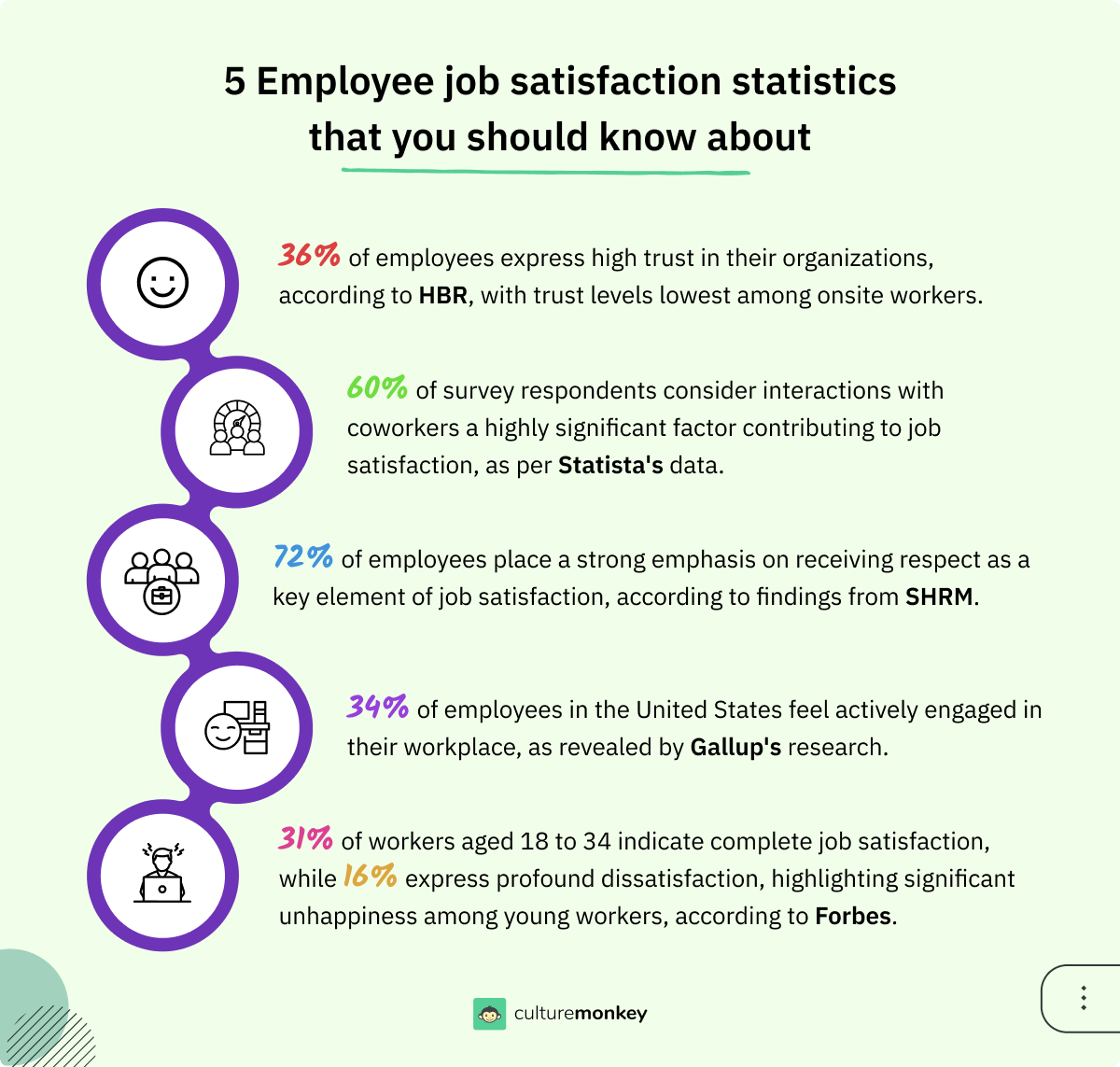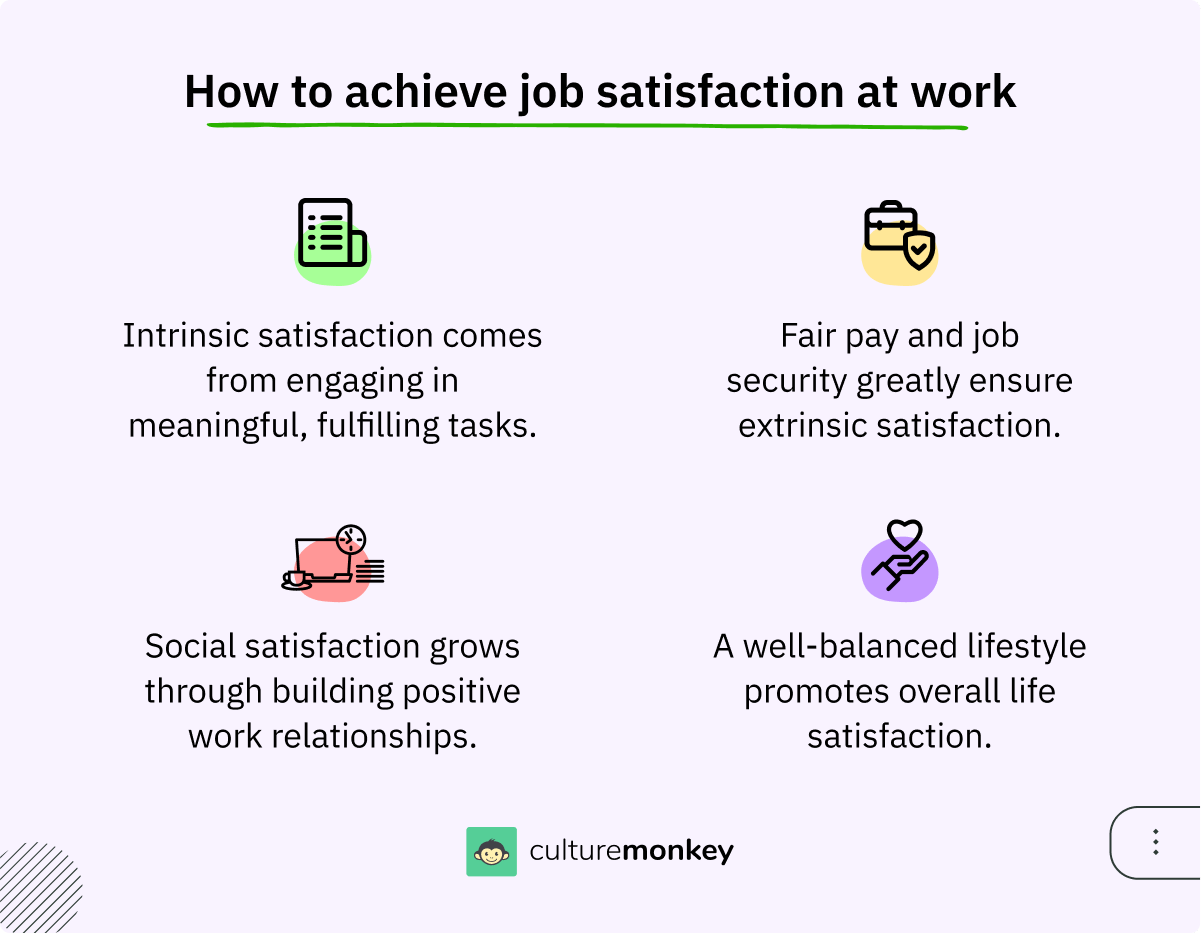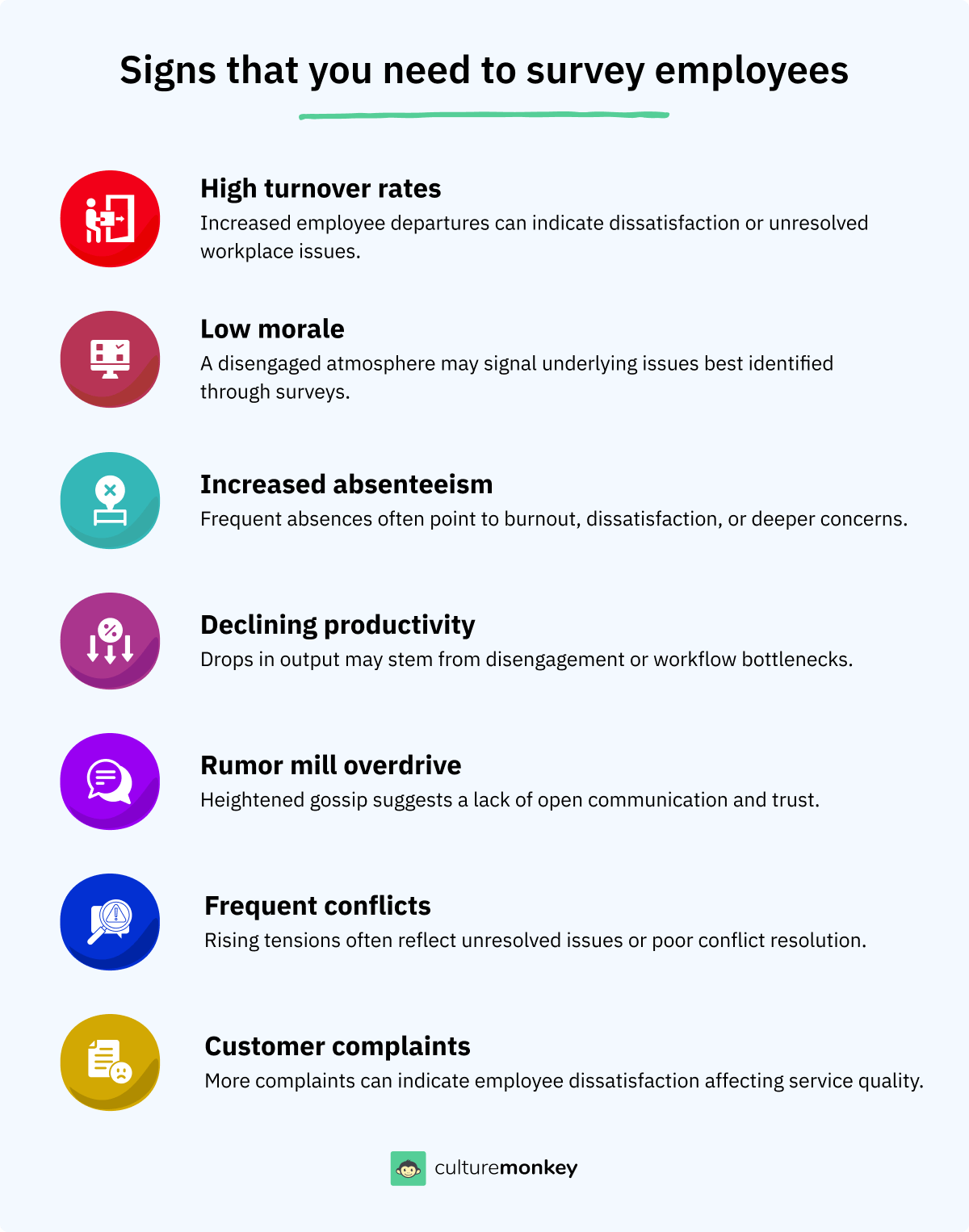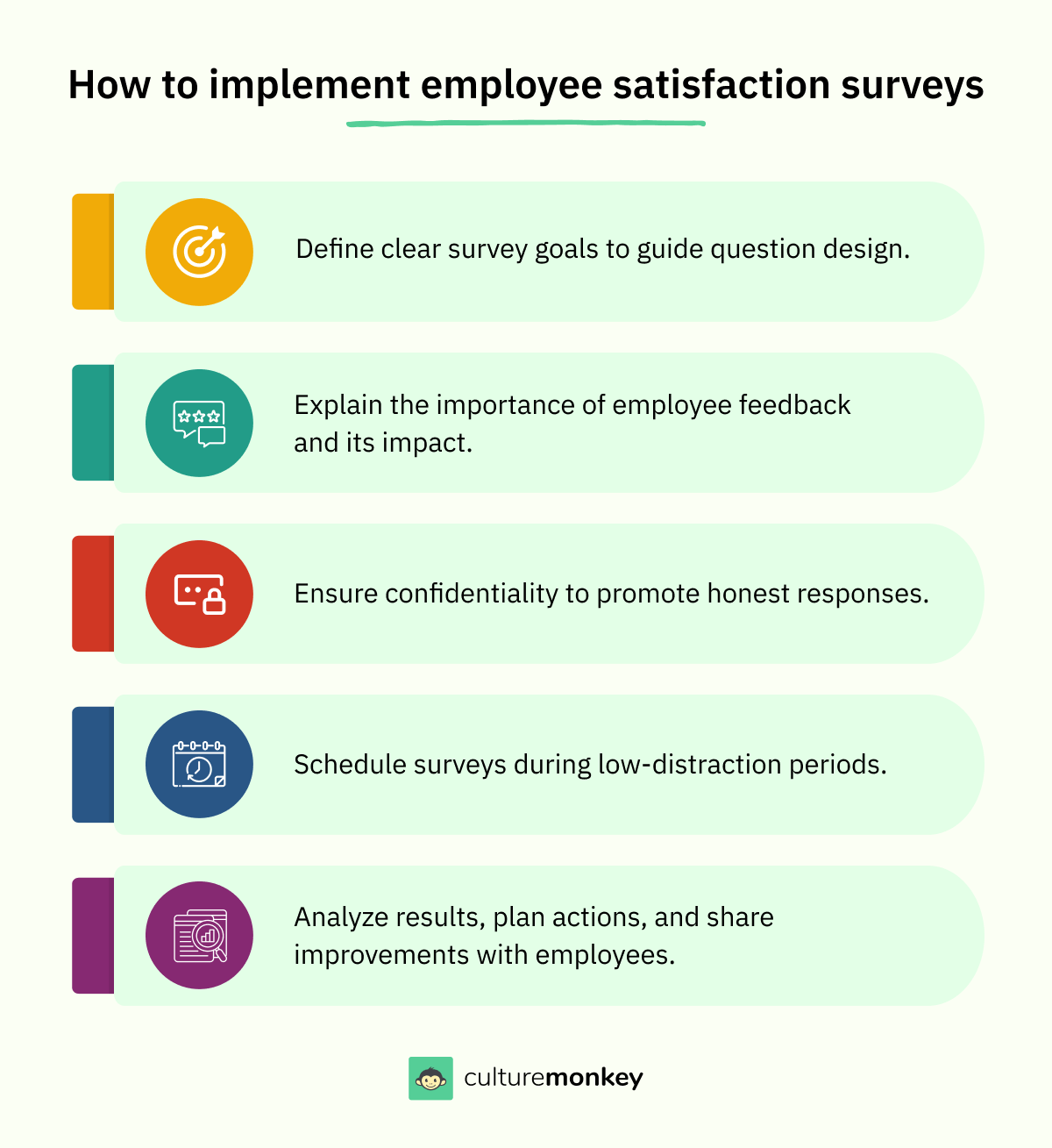75+ Employee satisfaction survey questions to boost engagement in 2025

Imagine it’s 1980, and Steve Jobs is about to launch the Apple Lisa, one of Apple’s earliest personal computers. The project was groundbreaking but notoriously chaotic behind the scenes.
Employees were burning out, and tensions were high, but Jobs, known for his relentless pursuit of perfection, rarely stopped to ask how his team felt about their work environment. The result? Delays, frustration, and a product that didn’t meet expectations.
Now, flip that scenario—what if Jobs had routinely asked his employees the right work satisfaction questions? Could the Lisa have been Apple’s first major hit instead of a commercial failure?
A study by Workforce Logiq showed that less than 20% of employees in the company engage with recruiters. The recruiters can be either HRs or Jobs himself (you know what we mean here.)
In today’s fast-paced business world, you don’t need to be an Apple exec to understand the importance of employee satisfaction. Asking the right employee engagement survey questions is the key to ensuring your team is heard, engaged, and ultimately, helping your company thrive.
Blog Highlights

What is employee satisfaction?

Employee satisfaction refers to the level of contentment employees feel regarding their job roles, work environment, and the overall workplace experience. It’s a measure of how happy or fulfilled they are with factors such as their daily tasks, management support, career growth opportunities, compensation, and workplace culture.
High employee satisfaction typically results in better productivity, lower turnover rates, and a more positive company atmosphere. When employees feel valued and satisfied, they are more likely to stay loyal and contribute meaningfully to the organization. On the other hand, low satisfaction can lead to disengagement, poor performance, and high turnover rates.
Tracking and improving employee satisfaction helps companies understand what is working and what needs to change, making it a critical part of building a thriving, engaged workforce. Regular satisfaction surveys are an effective way to gauge this and address any underlying concerns early.
Employee opinion survey vs employee satisfaction survey vs employee engagement survey

| Survey Type | Purpose | Focus Areas | Outcome | Frequency |
|---|---|---|---|---|
| Employee Opinion Survey | Gathers employees' views and attitudes on specific policies, management decisions, or workplace changes. | Policies, procedures, leadership effectiveness, workplace culture, organizational direction. | Provides feedback on organizational aspects, helping leaders make informed decisions about policy or process changes. | Typically conducted annually or when significant changes occur. |
| Employee Satisfaction Survey | Measures how content employees are with various aspects of their job and work environment. | Job role satisfaction, compensation, work-life balance, leadership support, workplace conditions. | Identifies areas of dissatisfaction, helping to improve employee morale and reduce turnover. | Can be conducted semi-annually or annually. |
| Employee Engagement Survey | Assesses the emotional commitment and connection employees have with the organization. | Commitment to the organization, motivation, sense of purpose, alignment with company values, willingness to go the extra mile. | Helps gauge overall employee engagement levels, enabling strategies to enhance employee retention and productivity. | Typically conducted once a year, with follow-up surveys as needed. |
Key Differences:
- Employee Opinion Surveys focus on specific topics like policies or leadership, aiming to gather employee perspectives on targeted issues.
- Employee Satisfaction Surveys measure overall happiness and contentment with job-related factors.
- Employee Engagement Surveys look at the emotional commitment employees have toward their work and the company, focusing on long-term dedication and productivity.
5 Employee job satisfaction statistics that you should know about

- According to HBR, a mere 36% of employees express high trust in their organizations, and this trust is lowest among onsite workers.
- As per Statista's data, 60% of survey respondents consider interactions with their coworkers to be a highly significant factor contributing to job satisfaction.
- SHRM's findings indicate that a substantial 72% of employees place a strong emphasis on receiving respect as a key element of job satisfaction.
- Gallup's research reveals that only 34% of employees in the United States feel actively engaged in their workplace.
- Forbes highlights that job satisfaction among workers aged 18 to 34 is relatively low, with only 31% indicating complete satisfaction and 16% expressing profound dissatisfaction, indicating a significant level of unhappiness among young workers.

What are the 4 types of job satisfaction?

Job satisfaction isn't just about the paycheck. It encompasses different aspects of your work life. Here are the four key types of job satisfaction:
- Intrinsic job satisfaction: This relates to the enjoyment and fulfillment you get from the tasks themselves. If you find your work intellectually stimulating and personally rewarding, you’re experiencing intrinsic satisfaction.
- Extrinsic job satisfaction: This focuses on external rewards like salary, bonuses, benefits, and job security. When these external factors are positive, they contribute to your extrinsic satisfaction.
- Social job satisfaction: Social satisfaction comes from your interactions at work—relationships with colleagues, supervisors, and teams. Positive, supportive workplace relationships boost social satisfaction.
- Life satisfaction: This refers to overall personal happiness, which impacts how you feel at work. A balanced life outside of work improves your attitude toward your job.

Why should you measure employee satisfaction?

Measuring employee satisfaction is crucial for several reasons, as it provides valuable insights into the overall health and effectiveness of an organization.
By understanding and assessing employee satisfaction, companies can make informed decisions and take proactive steps to improve the work environment, employee engagement, and organizational performance.
Here are some key reasons why measuring employee satisfaction is essential:
Employee retention
Employee engagement and satisfaction play a big role in retention. Happy employees are more likely to stay with an organization. Measuring satisfaction helps identify factors that contribute to employee turnover, allowing companies to address these issues and implement strategies to improve retention rates.
This, in turn, reduces recruitment and training costs associated with high turnover.
Productivity and performance
Happy employees tend to be more productive and perform better in their roles. By measuring satisfaction, organizations can identify areas where employees may be dissatisfied or facing challenges that hinder their performance.
Addressing these issues can boost productivity and help managers better overall organizational performance. According to a report by GALLUP, businesses can supercharge their profits by 21% if their workforce is engaged and satisfied.
Engagement and motivation
Employee satisfaction is closely linked to employee engagement. Engaged employees are passionate about their work, committed to the organization's goals, and motivated to go the extra mile.
Measuring satisfaction helps organizations understand the drivers of employee engagement and engagement and develop strategies to foster a culture that promotes motivation and engagement.
Organizational culture and climate
Employee satisfaction surveys provide insights into the overall organizational culture and work climate. It helps organizations gauge whether employees feel supported, valued, and included.
Identifying areas where the company's culture or climate may be lacking can guide efforts to create a more positive and inclusive work environment.
To back the importance of work culture, Statista worked up a report. It throws light on how employee satisfaction increases in a favorable work environment.
Feedback and continuous improvement
Measuring employee satisfaction provides a platform for employees to share their feedback, concerns, and suggestions. Provide effective feedback channels as they help organizations to improve processes, policies, and practices.
Regularly measuring and improving employee satisfaction allows companies to track progress over time and assess the impact of interventions and initiatives aimed at enhancing employee satisfaction.



The way your employees feel is the way your customers will feel.
President
Quality Service Marketing
Customer satisfaction
Employee satisfaction has a direct impact on customer satisfaction. Satisfied employees are more likely to provide exceptional customer service, leading to higher customer satisfaction and loyalty.
By measuring employee satisfaction, organizations can identify opportunities to improve service quality and create positive customer experiences.
Employee satisfaction survey KPI

Let's dive into the essential KPIs for employee satisfaction surveys:
- Response rate: The first sign of a successful survey is a healthy response rate. You want as many employees as possible to participate. Low response rates can indicate disengagement or lack of interest. Aim for at least 70% participation.
- Overall satisfaction score: This is the big one. Ask employees to rate their satisfaction on a scale, and calculate an overall satisfaction score. It's the pulse of your workplace morale. Monitor this score over time to see trends and spot issues.
- Engagement: Employee engagement is a critical KPI. Engaged employees are more productive and less likely to leave. Look for responses related to enthusiasm, commitment, and emotional connection to the organization.
- Net promoter score (NPS): Ask employees how likely they are to recommend your company as a great place to work. A high NPS suggests a healthy workplace, while a low score may indicate issues that need attention.
- Action plan effectiveness: After each survey, implement action plans to address identified issues. Track the progress and effectiveness of these plans. Are satisfaction scores improving in areas you've targeted for change?
Incorporating these KPIs into your first employee satisfaction survey strategy will help you measure the impact of your efforts and ensure a happier, more engaged workforce.
Remember, a successful survey isn't just about gathering data; it's about using that data to make positive changes and create a workplace where employees thrive.
Common challenges with measuring satisfaction and solutions
Measuring employee satisfaction may seem straightforward but often comes with significant challenges that can hinder accurate assessment. By addressing these obstacles, companies can ensure a clearer view of employee sentiment and take meaningful action. Here are common challenges and solutions to keep in mind:
1. Low response rates
- Challenge: Employees may be hesitant to participate in surveys due to time constraints, disinterest, or a belief that their feedback will not lead to change.
- Solution: Communicate the purpose and importance of the survey, ensure anonymity, and offer incentives to boost participation rates. Regular reminders and easy access across devices, including mobile, also encourage engagement.
2. Lack of honest responses
- Challenge: Employees may fear repercussions or may not trust that their feedback will be kept confidential, leading to biased or incomplete responses.
- Solution: Ensure confidentiality by using anonymous surveys and clearly communicate this assurance. Create a culture of openness where feedback is genuinely valued and acted upon to build trust.
3. Poorly designed survey questions
- Challenge: Ambiguous, leading, or irrelevant questions can result in unclear responses that do not provide actionable insights.
- Solution: Craft well-structured questions that are specific, unbiased, and aligned with clear survey objectives. Use a mix of quantitative (Likert scales, multiple choice) and qualitative (open-ended) questions for balanced insights.
4. Misinterpretation of results
- Challenge: Without proper context or segmentation, survey results can be misinterpreted, leading to ineffective actions or missed opportunities.
- Solution: Segment data by demographics, roles, or departments to identify trends accurately. Collaborate with HR and managers to analyze data and seek employee input for a well-rounded understanding.
5. Survey fatigue
- Challenge: Frequent or overly long surveys can lead to employee survey fatigue, reducing participation and the quality of responses over time.
- Solution: Limit survey frequency and keep them concise, focusing only on critical areas of concern. Use shorter pulse surveys periodically instead of lengthy, comprehensive ones and ensure that feedback results in visible change to maintain employee interest and engagement.
6. Cultural barriers
- Challenge: In diverse workplaces, cultural differences can influence how employees perceive and respond to survey questions, potentially skewing results or reducing participation from certain groups.
- Solution: Design culturally inclusive surveys by considering language preferences, regional norms, and varying communication styles. Employ localized surveys with multilingual options and collaborate with cultural representatives to ensure questions are contextually appropriate and respectful, fostering more accurate and inclusive responses.
What is the job satisfaction survey?

A job satisfaction survey is a tool used by organizations to measure how employees feel about various aspects of their jobs and work environment. It typically includes questions that assess factors such as job role satisfaction, compensation, career growth opportunities, work-life balance, management support, and workplace culture.
The goal of the survey is to identify areas where employees are satisfied or dissatisfied, allowing employers to address any issues and improve overall workplace morale. Job satisfaction surveys help organizations understand what motivates employees and what may be causing disengagement or turnover.
These surveys can be conducted anonymously to encourage honest feedback, and the results are often used to inform decisions related to employee retention, engagement strategies, and organizational improvements. Regularly conducting job satisfaction surveys provides valuable insights that can lead to a more motivated and productive workforce.
Signs that you need to survey employees

Have you ever felt like you're sailing blind in the workplace, unsure of what your employees really think and need? It's a common challenge, but fortunately, there are clear signs that it's time to survey your employees for valuable insights. Here are some indicators that it's survey time:
- High turnover rates: If you've noticed an uptick in employees jumping ship, it's a red flag. Surveying can help you uncover the underlying issues causing this trend, whether it's dissatisfaction with management, lack of growth opportunities, or other concerns.
- Low morale: When the office buzz feels more like a collective sigh, low morale is likely to blame. Employee surveys can help you pinpoint the sources of discontent, from heavy workloads to communication breakdowns.
- Increased absenteeism: Frequent sick days or unexplained absences can be an indicator of employees disengaging from their work. Surveys can reveal the root causes and guide improvements.
- Declining productivity: If you've noticed a dip in productivity, it's time to investigate. Employee feedback can shed light on bottlenecks, inefficient processes, or other factors affecting output.
- Rumor mill overdrive: When office gossip is running wild, it's a sign that communication channels may need an overhaul. Employee surveys can identify communication gaps and misperceptions.
- Lack of innovation: If your team isn't coming up with new ideas or is resistant to change, it may signal a need for fresh perspectives. Surveys can capture employee insights that spark innovation.
- Customer complaints: An increase in customer complaints could indicate that employees are facing challenges in delivering quality service. Surveys can help identify areas where additional training or support is needed.
- Frequent conflicts: If workplace conflicts are becoming the norm, it's essential to address the underlying issues. Surveys can uncover the sources of tension and guide conflict resolution strategies.
- Stagnant growth: When your organization seems stuck in a rut, it may be due to employee dissatisfaction or lack of motivation. Surveys can help you identify what's holding your team back.
- Competitors surpassing you: Falling behind your competitors? It could be a sign that your employees are not fully engaged or empowered. Surveys can uncover areas where you can regain a competitive edge.

Benefits of an employee satisfaction survey

Employee satisfaction surveys offer a wealth of benefits that go beyond a simple feedback collection process. Let's break down compelling advantages of conducting employee satisfaction surveys:
- Identifying issues: Employee satisfaction surveys serve as a magnifying glass for workplace problems. They help pinpoint specific issues, from communication breakdowns to work-related stress, that may be affecting morale.



Clients do not come first. Employees come first. If you take care of your employees, they will take care of the clients.
Founder
Virgin Group
- Boosting morale: When employees feel heard and valued through surveys, it can give them a morale boost. Knowing that their opinions matter and that the organization is willing to make improvements can lead to a happier workforce.
- Innovation: Surveys can uncover fresh ideas and innovative solutions from employees who work on the front lines. This feedback can lead to process improvements and new strategies.
- Improved communication: Clear and open communication are vital for any organization. Employee satisfaction surveys can highlight areas where communication needs to be enhanced, leading to better teamwork and collaboration.
- Data-driven decision making: Surveys provide data that leaders can use to make informed decisions. Instead of relying on gut feelings, organizations can base their strategies on concrete feedback.
- Competitive advantage: Organizations that prioritize employee satisfaction gain a competitive edge. Happy employees become brand ambassadors, attracting top talent and enhancing the company's reputation.
How do you structure a satisfaction survey?

When structuring a work satisfaction survey, it's important to create a clear and organized framework that effectively captures employee feedback.
Here are ten key considerations for structuring a staff satisfaction survey:
- Introduction: Begin the survey with a brief introduction that explains the purpose of the survey, reassures confidentiality, and highlights the importance of employee feedback. It's also helpful to include an estimated time for completion.
- Demographic information: Start by collecting basic demographic information such as job role, department, tenure, and other relevant details. This data allows for segmenting responses and analyzing satisfaction levels across different groups.
- Multiple choice and Likert scale questions: Use multiple-choice and Likert scale questions to gather quantitative data. These questions provide structured response options and allow for easy analysis. Include statements that cover different aspects of the work environment and satisfaction factors.
- Open-ended survey questions: Incorporate open-ended questions to encourage employees to provide detailed and qualitative responses. These questions can uncover specific issues, suggestions, and insights that may not be captured in closed-ended questions.
- Specific categories: Structure the survey into specific categories to cover various aspects of employee satisfaction, such as compensation, work-life balance, career development, leadership, and the company's mission and culture. This helps in organizing the survey and allows respondents to focus on specific areas of interest.
- Balanced format: Maintain a balanced format by alternating between positive and negative statements or questions. This helps avoid bias and ensures that employees can express both satisfaction and dissatisfaction.
- Order and flow: Arrange questions in a logical order that flows smoothly and makes sense to respondents. Begin with general questions before moving a few questions down into more specific areas. Group related questions together to maintain coherence.
- Avoid jargon and ambiguity: Use clear and concise language, avoiding technical jargon or ambiguous terms. Ensure that questions are easily understandable and do not lead to confusion or misinterpretation.
- Optional sections: Include optional sections for employees to provide additional comments, suggestions, or any other relevant information they would like to share.
- Closing and thank you: Conclude the survey with a closing message expressing appreciation for the employee's time and valuable feedback.
75+ Employee satisfaction survey questions related to workplace culture

Here are 75+ employee satisfaction survey questions related to the company culture:
- Do you feel that the organization's values align with your core values?
- To what extent does the organization promote a sense of teamwork and collaboration?
- How transparent do you perceive the communication within the organization?
- Do you feel that your contributions are valued and recognized by your colleagues and superiors?
- How would you rate the level of trust among coworkers and between employees and management?
- Are there opportunities for professional growth and advancement within the organization?
- Does the organization promote a healthy work-life balance?
- How well does the organization foster diversity and inclusion in the workplace?
- Is there a sense of mutual respect and support among employees?
- Are there channels for employees to provide feedback and have their concerns addressed?
- How well does the organization promote a positive and inclusive work environment?
- To what extent are employees encouraged to voice their opinions and ideas?
- Are there regular opportunities for employees to collaborate on cross-functional projects?
- How effectively does the organization promote a sense of fairness and equality in the workplace?
- Does the organization provide the necessary resources and tools for employees to perform their jobs effectively?
- Are there opportunities for employees to participate in decision-making processes that affect their work?
- How well does the organization recognize and celebrate employee achievements and milestones?
- Do employees have access to professional development and training opportunities?
- Is there a strong emphasis on work ethics and integrity within the organization?
- How well does the organization foster a sense of camaraderie and team spirit?
- Are there mechanisms in place to handle conflicts and disagreements fairly and constructively?
- Does the organization promote a culture of continuous learning and improvement?
- To what extent does the organization prioritize employee well-being and mental health?
- Are there open lines of communication between employees and management?
- Does the organization encourage a healthy work environment free from harassment and discrimination?
- How well does the organization promote a sense of pride and loyalty among its employees?
- How satisfied are you with the benefits and perks offered by the organization?
- Do you feel that your workload is manageable and conducive to maintaining a healthy work-life balance?
- Are you provided with opportunities to participate in skill-enhancing workshops or training sessions?
- How effective is the organization's feedback mechanism for addressing employee concerns and suggestions?
- Does the organization encourage cross-departmental collaboration to achieve common goals?
- Are there clear and well-communicated performance expectations and goals for your role?
- Do you feel that your direct supervisor provides you with the necessary support and guidance?
- How well does the organization handle and adapt to changes in the industry or market?
- Are there clear pathways for career advancement within your department or team?
- Does the organization offer flexible work arrangements or remote work options, where applicable?
- How satisfied are you with the organization's approach to recognizing and rewarding outstanding performance?
- Are there opportunities for employees to take on leadership roles or mentorship responsibilities?
- How would you rate the organization's commitment to environmental sustainability and corporate social responsibility?
- Does the organization effectively communicate its strategic goals and vision to employees?
- How well does the organization encourage innovation and creativity among employees?
- Are there programs or initiatives in place to promote physical well-being, such as fitness facilities or wellness programs?
- Do you feel that your job provides you with a sense of purpose and meaningful work?
- How satisfied are you with the organization's efforts to reduce bureaucracy and streamline processes?
- Are there clear avenues for reporting ethical concerns or potential misconduct?
- Does the organization support and promote employee involvement in community or charitable activities?
- How well does the organization manage and respond to external factors that may impact job security, such as economic trends or industry changes?
- How effective is the organization in fostering an open and collaborative communication style across all levels?
- Do you feel that the leadership team genuinely cares about the well-being of employees?
- How well does the organization support employees in maintaining a healthy work-life balance?
- Are you satisfied with the opportunities provided to innovate or improve processes in your role?
- Do you believe the organization invests in the professional growth of its employees?
- How satisfied are you with the current opportunities for internal mobility and lateral career moves?
- Do you feel comfortable providing honest feedback to your supervisor without fear of negative consequences?
- How effective is the organization in managing and recognizing employee workloads?
- Do you feel that your ideas and suggestions are taken seriously by management?
- How well does the organization support your efforts to achieve your career goals?
- Do you believe the organization provides a clear direction for the future?
- Are you satisfied with the organization’s approach to mental health support and resources?
- How would you rate the organization's commitment to diversity and inclusion across all departments?
- Do you feel encouraged to share new ideas for improving the company’s products or services?
- How effectively does the organization handle feedback from employee surveys or discussions?
- Are there mentorship or coaching programs available to help you grow professionally?
- Do you believe the organization has a strong focus on fostering leadership skills in its employees?
- How satisfied are you with the level of transparency about changes within the organization?
- Do you feel that the organization provides clear expectations regarding your role and responsibilities?
- How well does the organization recognize and address the professional needs of remote employees?
- Are there opportunities to take part in organizational strategy discussions or planning sessions?
- How satisfied are you with the company’s onboarding process for new hires?
- Does the organization provide clear communication on the impact of individual roles in achieving business goals?
- Are employees encouraged to take ownership of their projects and responsibilities?
- How satisfied are you with the organization’s efforts to reduce workplace stress?
- Do you feel the organization is proactive in resolving any challenges or barriers to your productivity?
- How well does the organization recognize and celebrate team collaboration and group achievements?
- Do you believe the organization is committed to continuous improvement and development for all employees?
- How satisfied are you with the opportunities to provide input on company policies that affect your job?
- Do you feel the organization empowers employees to make decisions that impact their work?

Discover What Employees Really Think.
Download the Employee Satisfaction Survey Questions to gather valuable insights and boost engagement within your team.
Download NowEmployee satisfaction survey questions on reward and recognition
Here are 10 employee satisfaction questionnaire focused on reward and recognition:
- Do you feel that your contributions are recognized in a timely manner by your manager or team?
- How satisfied are you with the criteria used to determine rewards and recognition in the company?
- Do you feel that the reward and recognition system is fair across all departments?
- Are you satisfied with the frequency of recognition you receive for your efforts?
- Do you believe the organization provides enough non-monetary recognition for achievements (e.g., public acknowledgment, certificates)?
- How effective is the organization in celebrating team achievements and milestones?
- Do you feel that your efforts are recognized equally compared to others with similar roles?
- Are there clear guidelines on how to earn rewards or recognition within your role?
- Do you believe the rewards and recognition you receive align with your level of effort and contribution?
- How satisfied are you with the opportunities to nominate peers or colleagues for recognition?
The science behind these questions

The science behind employees' job satisfaction survey questions is rooted in psychology, organizational behavior, and data analytics. These questions are carefully designed to tap into the key drivers of employee satisfaction—such as job role fulfillment, workplace relationships, leadership, compensation, and growth opportunities.
By leveraging frameworks like Maslow’s Hierarchy of Needs or Herzberg’s Two-Factor Theory, each question helps uncover how well the work environment meets employees’ needs. Quantitative data from scaled questions reveal trends and patterns, while qualitative open-ended responses provide deeper insights into underlying issues.
Ultimately, these questions allow employers to identify areas for improvement and take data-driven actions that positively impact engagement, retention, and overall organizational performance, ensuring a healthier and more productive work culture.
What questionnaires are used to measure work satisfaction?
Work satisfaction questionnaires are carefully crafted tools that help organizations measure how happy, motivated, and fulfilled employees feel in their roles. These questionnaires typically cover various aspects of the job, such as day-to-day tasks, management support, work-life balance, and opportunities for growth.
The science behind each question is rooted in organizational psychology, aiming to understand the drivers of motivation and satisfaction.
Here are four common types of questions used to measure work satisfaction:
1. "On a scale of 1 to 10, how satisfied are you with your current role?"
This question offers a clear, quantitative way to measure overall satisfaction. The numeric scale allows for easy comparison and tracking over time. It taps into basic emotional reactions to job satisfaction, providing a baseline measurement.
2. "Do you feel that your work is valued by your manager and peers?"
This question focuses on social recognition and validation, two significant factors in work satisfaction. The science here involves understanding the human need for validation and positive reinforcement, which boosts morale and engagement.
3. "How often do you feel challenged by your tasks at work?"
This question examines the balance between challenge and skill, often linked to flow theory, where people are happiest when they are fully immersed in a task that pushes their abilities. It’s a way to measure whether employees feel engaged or bored in their roles.
4. "Do you believe there are enough opportunities for career growth within the organization?"
Career development is a key driver of long-term satisfaction. This question taps into Maslow’s Hierarchy of Needs, focusing on self-actualization and the desire for personal growth, which is crucial for sustaining motivation and loyalty.
How to implement employee satisfaction surveys?

Define objectives
- Clearly outline the objectives of the survey.
- Identify specific areas or issues to address.
- Set goals you want to achieve through the survey.
- Use these objectives to guide the survey design and focus.
Determine survey method
- Decide on the method of survey administration.
- Consider factors like workforce size, access to technology, and confidentiality needs.
- Choose between online surveys, paper-based surveys, or a combination.
Design the survey
- Develop the questionnaire based on the defined objectives.
- Include a mix of closed-ended and open-ended questions.
- Ensure questions are clear, unbiased, and relevant to the goals.
Ensure anonymity and confidentiality
- Assure employees that their responses will remain anonymous and confidential.
- Emphasize the survey’s purpose is to gather insights for improvement, not to evaluate individual performance.
Communication and introduction
- Communicate the survey’s purpose and importance to both management and employees.
- Explain how team feedback survey will be used to drive positive changes.
- Introduce the survey in advance with details about the timeline, method, and incentives.
Pilot testing
- Conduct a pilot test with a small group of employees.
- Identify potential issues or ambiguities in the survey.
- Make necessary adjustments based on feedback.
Launch the survey
- Distribute the survey using the chosen method (online platform or paper).
- Provide clear instructions on how to access and complete the survey.
- Set a deadline for submission.
Follow-up and reminders
- Send reminders to encourage participation.
- Offer assistance or clarification if needed to ensure high response rates.
Data collection and analysis
- Collect and compile the survey responses.
- Analyze the data to identify trends and areas of concern.
- Use both quantitative and qualitative data for comprehensive insights.
Action planning
- Develop an action plan based on the survey results.
- Involve relevant stakeholders (HR, managers, employee representatives).
- Set clear goals, assign responsibilities, and establish timelines for improvements.

Tips for increasing employee participation

- Offer incentives: Providing benefits package such as gift cards, extra time off, or company swag can motivate employees to complete the survey. Incentives encourage faster participation and higher response rates.
- Ensure survey transparency: Clearly explain how the survey results will be used to improve the workplace. When employees know their feedback drives real change, they are more likely to participate with no survey fatigue.
- Communicate the purpose: Share the importance of the survey and how it benefits employees. Highlight that their input is vital to shaping policies and improving company culture.
- Keep surveys anonymous: Guarantee anonymity to encourage honest responses. Employees are more willing to share candid feedback if they feel safe from repercussions.
- Send friendly reminders: Use personalized, gentle reminders to boost participation. Emphasize the deadline, and express the value of every individual’s feedback.
- Make surveys easy to access: Ensure the survey is simple to access across devices. Mobile-friendly surveys and quick links can make participation more convenient.
- Limit survey length: Keep the survey concise and focused to respect employees’ time. A short, straightforward survey is more likely to be completed than a lengthy one.
- Share results and action plans: After gathering feedback, communicate the findings and the steps being taken based on responses. This shows employees that their opinions matter.
- Involve leadership: When managers and leadership emphasize the importance of the survey and personally encourage participation, employees are more likely to engage.
- Create a positive feedback loop: Foster a culture of feedback by regularly conducting surveys and acting on the results. When employees see improvements based on past surveys, they’ll be more likely to participate in future ones.
How surveys can predict turnover and influence company culture?
1. Identifying early signs of disengagement
Surveys are powerful tools for spotting early signs of employee disengagement, which often precedes turnover. Questions related to job satisfaction, work environment, and employee morale can uncover whether employees feel undervalued or disconnected.
Disengagement can manifest in feelings of being unappreciated, lack of motivation, or feeling stagnant in one’s role. By analyzing responses to these types of questions, organizations can identify employees who may be at risk of leaving long before they hand in their resignation.
2. Understanding key drivers of turnover
Surveys allow organizations to gather direct insights into the reasons employees may consider leaving. Common turnover drivers include poor work-life balance, insufficient recognition, lack of career advancement opportunities, and inadequate compensation.
By asking employees about their level of satisfaction in these areas, organizations can pinpoint the factors contributing to potential turnover. This data-driven understanding helps companies prioritize action in specific areas, reducing the likelihood of employees leaving due to unaddressed concerns.
3. Measuring employee engagement and loyalty
Employee surveys can measure not only satisfaction but also loyalty and engagement. Engagement-related questions focus on the emotional connection employees have with their work and the company’s mission.
High engagement levels are linked to lower turnover rates, as engaged employees are more invested in the success of the organization. Surveys that measure engagement can reveal whether employees feel aligned with company values and goals, which influences their decision to stay or leave.
4. Predicting patterns through data analysis
Surveys, when conducted regularly, offer a wealth of data that can be analyzed for patterns and trends. Predictive analytics can be applied to survey data to forecast turnover trends based on historical responses.
For example, employees expressing dissatisfaction with management support or a lack of development opportunities may have a higher risk of turnover. By leveraging this data, organizations can predict which departments or job roles are most vulnerable to attrition.
5. Shaping and reinforcing company culture
Surveys not only help predict turnover but also play a crucial role in shaping and reinforcing company culture. Employee feedback on organizational values, management practices, and work-life balance helps companies understand how their culture is perceived.
Positive responses indicate alignment between employees and company culture, while negative feedback highlights areas for improvement. By acting on this feedback, organizations can make cultural adjustments that promote retention.
How to interpret employee satisfaction survey results and take the best actions out of it?

Segment the data
- Break down survey results based on demographics like department, job role, or tenure.
- This allows for a more detailed analysis of satisfaction levels among different groups.
- Look for disparities or significant differences in satisfaction across segments.
Prioritize areas of concern
- Identify key areas that need immediate attention based on the survey results.
- Focus on the main drivers of employee satisfaction that have the most influence on the overall experience.
- Prioritize these areas to improve employee engagement.
Analyze open-ended responses
- Review qualitative feedback from open-ended questions for common themes or suggestions.
- Look for specific examples that explain the reasons behind satisfaction or dissatisfaction.
- Use these insights to guide your decision-making process.
Seek clarification if needed
- If any trends or responses are unclear, consider conducting follow-up discussions or focus groups.
- Gain further insights from employees to clarify ambiguities and deepen understanding of key issues.
Collaborate with stakeholders
- Involve HR, managers, and employee representatives in interpreting the results.
- Get their input to fully understand the challenges and opportunities highlighted by the survey.
- Use their perspectives to form a well-rounded view of the findings.
Develop an action plan
- Based on survey findings, create a clear action plan with specific strategies to address concerns.
- Set realistic goals, assign responsibilities, and create timelines for implementing changes.
- Ensure the action plan aligns with the organization’s overall goals and resources.
Implement and monitor progress
- Execute the action plan and monitor the progress of the initiatives.
- Regularly assess the impact of the actions taken and make adjustments as needed.
- Track employee satisfaction with follow-up surveys to evaluate the effectiveness of interventions over time.
The role of HR analytics and AI-based tools in making sense of large data sets

- Data organization: HR analytics tools categorize and organize large data sets, making it easier to analyze employee information such as satisfaction, performance, and turnover patterns without manual sorting.
- Identifying trends: AI-based tools can detect patterns and trends across multiple data points, helping HR teams understand employee behavior, satisfaction, and engagement over time.
- Predictive analytics: AI can predict future outcomes like turnover risk or engagement levels based on past data, enabling proactive strategies to retain employees and boost morale.
- Sentiment analysis: AI can process open-ended responses in surveys, using natural language processing (NLP) to detect employee sentiment and gauge overall satisfaction.
- Real-time feedback: AI tools can analyze employee feedback instantly, providing real-time insights for quick decision-making, rather than waiting for manual analysis.
- Customized reporting: HR analytics platforms generate customized reports, summarizing complex data into easily understandable insights for managers and HR professionals to act on.
- Identifying skill gaps: AI-based tools can track employee performance and learning progress, identifying skill gaps and suggesting targeted training or development opportunities.
- Benchmarking: HR analytics enables organizations to compare their workforce data against industry benchmarks, helping to understand where they stand in terms of engagement, turnover, and diversity.
- Automation of repetitive tasks: AI tools can automate data collection and analysis tasks, freeing HR teams to focus on more strategic initiatives, like improving culture or developing talent.
- Diversity and inclusion monitoring: Analytics tools track demographic data and assess the effectiveness of diversity and inclusion initiatives, helping to ensure fair representation and engagement across groups.
- Enhanced decision-making: AI helps HR teams make data-driven decisions by offering actionable insights based on detailed analysis, leading to more effective workforce management.
- Cost-efficiency: By automating data processing and reporting, AI-based tools reduce the time and cost associated with manual data analysis, improving overall HR efficiency.
- Employee performance forecasting: HR analytics tools predict employee performance trends, allowing managers to recognize potential high performers and those who may need support, aiding in better resource allocation.
Conclusion
Employee satisfaction surveys are vital for understanding how employees feel about their work environment, leadership, and opportunities for growth. CultureMonkey’s employee engagement survey platform makes the process of gathering and analyzing this feedback easy and effective.
With its fully customizable, multilingual survey options, annual employee survey features, CultureMonkey helps organizations reach every part of their workforce, ensuring diverse and inclusive feedback.
The platform also provides pulse surveys for real-time insights and a GPT-powered analytics system that quickly processes feedback to provide actionable data.
By using CultureMonkey, businesses can continuously monitor satisfaction and make data-driven decisions to improve employee experience, ultimately boosting engagement and retention. Learn more about CultureMonkey at CultureMonkey.
Summary
Employee satisfaction surveys are essential for understanding employee needs, boosting engagement, and creating a thriving workplace. This blog covers survey importance, key types, effective KPIs, and practical tips.
By measuring satisfaction and acting on feedback, organizations can reduce turnover, enhance productivity, and foster a supportive culture. Customizable and multilingual surveys provide diverse feedback and data-driven insights, leading to improved engagement, loyalty, and business success.
FAQs
1. How to create an effective job satisfaction survey?
Creating an effective job satisfaction survey involves careful planning. Start by defining your objectives and the specific aspects of job satisfaction you want to measure. Craft clear and concise questions that address those areas using a mix of open-ended and scaled questions. Pre-test the survey with a small group to identify any issues with wording or structure.
2. What are the best questions to include in a job satisfaction survey?
The best questions for a job satisfaction survey cover various aspects of the work experience. Start with general questions about overall satisfaction, then delve into specific areas like communication, work-life balance, opportunities for growth, and relationships with colleagues. Use a mix of closed-ended questions (e.g., rating scales) and open-ended questions to gather qualitative feedback.
3. Why is a job satisfaction survey important for organizations?
Job satisfaction surveys are crucial for organizations because they provide valuable insights into employee sentiment and engagement. They offer a structured way to gauge how employees feel about their work, colleagues, and the organization as a whole. By identifying areas of concern or discontent, organizations can address issues that may lead to high turnover or decreased morale.
4. What are the key benefits of conducting a job satisfaction survey?
Conducting a job satisfaction survey offers several key benefits for organizations. First and foremost, it provides insights into employee sentiment and identifies areas of concern, allowing for targeted improvements. Surveys help increase employee engagement and morale by demonstrating that their opinions matter and can lead to positive changes. They can enhance communication between leadership and staff, fostering a more transparent and open culture.
5. How can companies improve employee satisfaction based on survey results?
Improving employee satisfaction based on survey results requires a strategic approach. Start by analyzing the survey data to identify specific pain points and areas for improvement. Next, prioritize the issues that have the most significant impact on satisfaction and address them with targeted action plans. Communicate these plans to employees and involve them in the process.
6. How often should you conduct employee satisfaction surveys?
Employee satisfaction surveys should ideally be conducted quarterly or biannually. This frequency allows for regular feedback, giving you enough time to implement changes while maintaining a clear understanding of employee sentiment. However, depending on your organization’s needs, you may choose to adjust the timing. The key is consistency in collecting feedback and acting on it promptly to improve satisfaction and engagement.
7. How can I use the feedback from employee satisfaction surveys to improve company culture?
Use feedback from employee satisfaction surveys to identify areas needing improvement, such as communication, leadership, or recognition. Actively address concerns by implementing targeted changes and involve employees in the process. Regularly communicate progress to show commitment to improvement. This helps foster a culture of openness, trust, and continuous development, leading to a more engaged and positive workplace.




